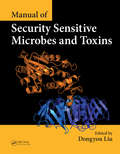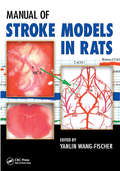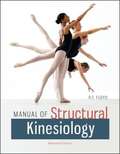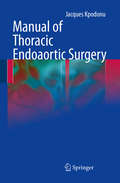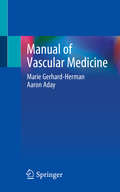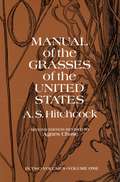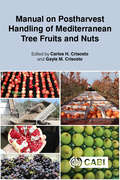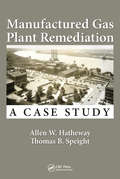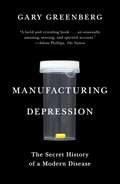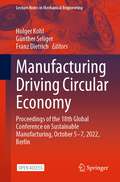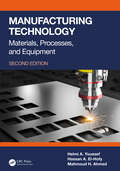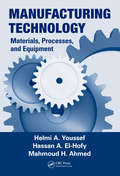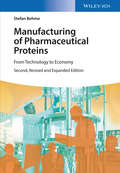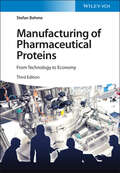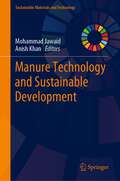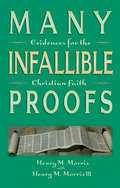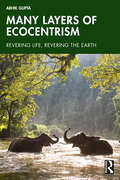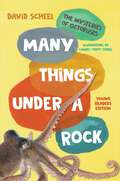- Table View
- List View
Manual of Security Sensitive Microbes and Toxins
by Dongyou LiuSecurity sensitive microbes (viruses, bacteria, fungi, and parasites) and toxins, which are often referred to as the select agents and toxins, have the capacity to cause serious illness and death in humans, animals, and plants.This book is an authoritative and comprehensive review of security sensitive microbes (viruses, bacteria, fungi, and parasites) and toxins, with an emphasis on the state of the art in the field. Written by experts in the field, the chapters present authoritative reviews, each one covering a single microbe or toxin with respect to its classification, biology, epidemiology, pathogenesis, identification, diagnosis, treatment, and prevention. The chapters also discuss the limitations of our current knowledge and challenges relating to improved detection and control of the microbe or toxin.
Manual of Stroke Models in Rats
by Yanlin Wang-FischerDuring the last few years, exciting new insights into mechanisms and treatment of stroke have been obtained from animal experiments. Hence, the use of animal models to induce stroke are of paramount importance as research tools. While a few articles on this topic have been published in select journals, until now there has not been a systematic tech
Manual of Structural Kinesiology
by R. T. Floyd Aron Thompson Clem ThompsonExplaining the process of human movement, Manual of Structural Kinesiology gives a straightforward view of human anatomy and its relation to movement. The manual clearly identifies specific muscles and muscle groups and describes exercises for strengthening and developing those muscles. Floyd provides important information in an accessible format through a combination of logical presentation, illustrations, and concise writing style.
Manual of Thoracic Endoaortic Surgery
by Jacques KpodonuThere is currently no standard manual for easy reference that is pocket sized and easy to read prior to planning such a case. The manual will also be a simple reference guide for residents, fellows in cardiovascular interventions as well as device representatives from Medtronic, Cook, Gore and Bolton.
Manual of Vascular Medicine
by Marie Gerhard-Herman Aaron AdayThis practical manual makes clinical vascular medicine easy for the health care provider to master by providing frameworks for each area of diagnosis and a practical approach to necessary testing. Rather than providing long lists of possible diagnoses for a clinical question, each approach is broken down into a flow chart of the thinking and questions necessary so that only those needed in each situation are utilized. Chapters cover a broad range of topics including arterial and venous testing in the laboratory, thrombophilia, cold disorders of the extremities and lymphatic diseases. Manual of Vascular Medicine provides extensive case-based learning for trainees and practicing physicians looking to expand their knowledge in this field that crosses many traditional disciplines. It is therefore of importance to any medical professional managing vascular patients, including cardiovascular and vascular physicians, nephrologists, neurologists, phlebologists, dermatologists, general medical doctors and vascular radiologists.
Manual of the Grasses of the United States, Volume One
by A. S. U.S. Dept. of Agriculture A. S. HitchcockThis work is actually the definitive encyclopedia of United States grass life. Compiled from the U.S. National Herbarium collection, the largest of its kind in the world, it is the only complete manual of U.S. grasses available and one of the basic reference works on U.S. plant life. It catalogs and describes in detail all 1,398 numbered species in 169 numbered genera found in this country, plus 120 species in 16 genera of the so-called “waifs.” Professor Hitchcock is the former Chief Botanist in charge of systematic agrostology for the U.S. Department of Agriculture, by whom the work was originally published, and an internationally known authority.The heart of the book is its detailed descriptions of the family of grasses, the two main subfamilies, the tribes, genera, and species. Quick finding keys are provided for the identification of tribes and genera. Each of the species is given thorough botanical description, including various aspects of its morphology — size, shape, form of culms, blades, panicles, spikes, and flowers — and height, proper planting season, and range of distribution are noted. The Manual also outlines the common uses to which grasses are put and discusses in general terms their distribution, classification, nomenclature, and common names. The 1,199 drawings make identification of any grass species found in the United States a virtual certainty. The appended synonymy of alternate names for each species provides an authoritative taxonomy, eliminating confusion.The nature lover with no more technical equipment than a keen eye can use this manual with profit, for a glossary of botanical terms is included. Naturalists, botanists, agriculturists, and horticulturists will find it valuable as a field and research guide to virtually all the grasses that grow in this country.
Manual of the Grasses of the United States, Volume Two
by A. S. U.S. Dept. of Agriculture A. S. HitchcockThis work is actually the definitive encyclopedia of United States grass life. Compiled from the U.S. National Herbarium collection, the largest of its kind in the world, it is the only complete manual of U.S. grasses available and one of the basic reference works on U.S. plant life. It catalogs and describes in detail all 1,398 numbered species in 169 numbered genera found in this country, plus 120 species in 16 genera of the so-called “waifs.” Professor Hitchcock is the former Chief Botanist in charge of systematic agrostology for the U.S. Department of Agriculture, by whom the work was originally published, and an internationally known authority.The heart of the book is its detailed descriptions of the family of grasses, the two main subfamilies, the tribes, genera, and species. Quick finding keys are provided for the identification of tribes and genera. Each of the species is given thorough botanical description, including various aspects of its morphology — size, shape, form of culms, blades, panicles, spikes, and flowers — and height, proper planting season, and range of distribution are noted. The Manual also outlines the common uses to which grasses are put and discusses in general terms their distribution, classification, nomenclature, and common names. The 1,199 drawings make identification of any grass species found in the United States a virtual certainty. The appended synonymy of alternate names for each species provides an authoritative taxonomy, eliminating confusion.The nature lover with no more technical equipment than a keen eye can use this manual with profit, for a glossary of botanical terms is included. Naturalists, botanists, agriculturists, and horticulturists will find it valuable as a field and research guide to virtually all the grasses that grow in this country.
Manual of the Vascular Flora of the Carolinas
by C. Ritchie Bell Harry E. Ahles Albert E. RadfordThis illustrated manual describes and discusses the unusually rich and varied flora of the Carolinas, from the semi-tropical coast of South Carolina to the northern forests of the high North Carolina mountains. The manual treats in detail and in a concise format more than 3, 200 species of trees, shrubs, vines, herbs and ferns that grow without cultivation in this two-state area. Special features include diagnostic illustrations, keys for identification, detailed descriptions, flowering and fruiting dates, habitat data, distribution data, and pertinent synonymy for each species. County dot maps show the distribution of each species if found in more than five counties throughout the two-state area, and general ranges beyond our borders are given in the text.First published in 1968, Manual of the Vascular Flora of the Carolinas is an established reference for professionals, students, and plant enthusiasts throughout the Southeastern United States. It is based on the collection and examination of more than 200,000 live specimens. Many of these specimens are now housed in the herbarium at the University of North Carolina at Chapel Hill
Manual on Postharvest Handling of Mediterranean Tree Fruits and Nuts
by George Athanasios Manganaris Sebastián Sáa Silva Cristina Besada Reinaldo Campos-Vargas Giancarlo Colelli Joseph H Connell Gemma Echeverria Louise Ferguson Margarita López Corrales Amnon Lichter Alejandra Salvador Manuel Joaquín Serradilla Sánchez Daniel Valero GarridoPostharvest is an important element of getting fresh, high-quality fruit to the consumer and technological advances continue to outpace infrastructure. This book provides valuable, up-to-date information on postharvest handling of seven fruit and nut crops: almond, fig, peach, persimmon, pistachio, pomegranate and table grape. These crops are of particular importance in the Mediterranean region, but also to those countries that export and import these crops, where intensive economic resources are dedicated to developing information to understand and solve their postharvest problems. Written by a team of internationally-recognized postharvest experts, this manual collates and verifies essential, but often difficult to access, information on these important crops, that is pertinent to the world's agricultural economy and affects agricultural communities. The book: Covers relevant postharvest topics for each crop across harvesting, packing, shipping and retail postharvest phases. Has an emphasis on knowledge useful to solve current worldwide industry problems. Includes practical recommendations. Makes available for the first time in English information previously published in other languages. Includes up-to-date references and high-quality photos that make it an excellent resource for postharvest educators and students. This is a must-have manual for growers and commodity handlers, cold storage managers, transportation personnel, produce managers and retail handlers, researchers, or anyone in the food chain that packs, transports, stores and sells these fruits and nuts.
Manual to Veterinary Video-Oto-Endoscopy: Use and Utility in Canine and Feline Ear Diseases
by Giovanni GhibaudoThis atlas provides a step-by-step manual in using the video-oto-endoscope (VOE) as a tool to study ear diseases in cats and dogs. Illustrated by numerous high-resolution images and case studies, the book explains in a highly accessible manner when and how to use VOE. It teaches how to differ between a normal and a pathological animal ear and guides the reader in diagnosing a particular disease. The book's main section provides in-depth information on causes, clinical picture, and imaging of ear diseases such as acute otitis externa, chronic otitis externa, and otitis media in small animals. Moreover, the atlas introduces technical fundamentals of the instrument and gives tips for its correct handling and cleaning. Further, readers are instructed on how to best prepare the animal patient for examination by VOE. The atlas addresses veterinary practitioners and veterinary technicians who are interested in performing otological examinations in cats and dogs.
Manualito de imposturología física
by Fernando Vallejo"«El ser humano es una bestia bípeda entrenada durante cuatro millones de años de evolución (contados desde que bajó del árbol) para mentir de las formas más sutiles, de las cuales hoy por hoy las más prestigiosas son la palabra y las ecuaciones». Fernando Vallejo, que ya en otro libro de ensayos se había despachado de manera despiadada a Darwin, arremete en éste con igual rabia e inteligencia contra los que considera los máximos impostores de la ciencia, ahora del campo de la física. Este Manualito de imposturología física, además de plantear muy bien qué fue lo que trataron de entender estos «genios de la impostura» (Newton, Maxwell y Einstein, entre otros), explica por qué fracasaron en su intento. Aun para aquellos que nunca antes se hayan interesado por las teorías de Newton o las «marihuanadas» de Einstein, éste es un libro claro, instructivo y revelador. Una vez más Fernando Vallejo demuestra que la suya es una pluma ácida y lúcida, que no le teme a ningún tema ni a ninguna vaca sagrada."
Manuel Cardona
by Klaus Ensslin Luis ViñaThis book pays tribute to an extraordinary researcher and personality, Manuel Cardona. He had significant influence in the development of science and inside the scientific community. The book consists of contributions by former collaborators and students of Prof. Manuel Cardona. The short contributions deal with personal encounters with Manuel Cardona describing his extraordinary personality. This includes descriptions of scientific discussions, Manuel Cardona's involvement in social justice and his enormous knowledge about human culture, languages and history.
Manufactured Gas Plant Remediation: A Case Study
by Allen W. Hatheway Thomas B. SpeightThe assessment, remediation, and redevelopment of manufactured gas plant (MGP) sites pose a significant technical and financial challenge to successor property owners, including municipalities and other public entities undertaking brownfields revitalization, and to their consulting environmental engineers. Due to the toxicity of many coal tar constituents, sites contaminated as a result of gasworks operations pose a significant threat to public health. This book will discuss the history of the manufactured gas industry in Massachusetts (the largest in the US), as well as the toxicity of gasworks waste products, technical challenges in the cleanup process, and the process for site cleanups.
Manufacturing Automotive Components from Sustainable Natural Fiber Composites (SpringerBriefs in Materials)
by Mohammad Jawaid Mohamad Midani Lobna A. Elseify Ayman El-BadawyThis book focuses on the use of natural fiber composites (NFCs) in the automotive industry. The new race in the automotive industry is no longer speed, but rather low weight and sustainable. Major automakers and component suppliers are now shifting to natural fiber reinforcements for their composite components as a sustainable and lightweight alternative to conventional, synthetic reinforcements. The main object of this book is to bridge the gap between academic literature and actual industry practices, and to provide a comprehensive and integrated review on the use of NFC in the automotive industry from composite fabrication to recycling. The book focuses on the major areas of interest to academic researchers, such as the history of NFC in the automotive industry, specific types of materials used, material qualification programs, major technical challenges facing NFC, major processing techniques and parameters, analysis of major NFC parts used and their performance requirements, sustainability assessments including life cycle assessment and carbon footprint, and future trends.
Manufacturing Depression: The Secret History of a Modern Disease
by Gary GreenbergGary Greenberg's fascinating argument about the uniquely American pursuit of anti-depression rather than happiness.
Manufacturing Driving Circular Economy: Proceedings of the 18th Global Conference on Sustainable Manufacturing, October 5-7, 2022, Berlin (Lecture Notes in Mechanical Engineering)
by Holger Kohl Günther Seliger Franz DietrichThis is an open access book. It gathers the proceedings of the 18th Global Conference on Sustainable Manufacturing, held on October 5-7, 2022, as a hybrid event, in/from Berlin, Germany. With a focus on manufacturing advances and practices driving the circular economy, the chapters selected for this book report on sustainable manufacturing technologies for the mobility, energy and construction sector, and for machines and equipments, covering applications of artificial intelligence and industry 4.0. Moreover, they discuss energy-efficient process, waste reuse, and CO2 neutral production, giving a special emphasis to developing sustainable manufacturing in emerging countries. This book offers extensive and timely information for both researchers and professionals in the field of manufacturing and business development.
Manufacturing Technology: Materials, Processes, and Equipment
by Helmi A. Youssef Hassan A. El-Hofy Mahmoud H. AhmedThis new edition textbook provides comprehensive knowledge and insight into various aspects of manufacturing technology, processes, materials, tooling, and equipment. Its main objective is to introduce the grand spectrum of manufacturing technology to individuals who will be involved in the design and manufacturing of finished products and to provide them with basic information on manufacturing technologies.Manufacturing Technology: Materials, Processes, and Equipment, Second Edition, is written in a descriptive manner, where the emphasis is on the fundamentals of the process, its capabilities, typical applications, advantages, and limitations. Mathematical modeling and equations are used only when they enhance the basic understanding of the material dealt with. The book is a fundamental textbook that covers all the manufacturing processes, materials, and equipment used to convert the raw materials to a final product. It presents the materials used in manufacturing processes and covers the heat treatment processes, smelting of metals, and other technological processes such as casting, forming, powder metallurgy, joining processes, and surface technology. Manufacturing processes for polymers, ceramics, and composites are also covered.The book also covers surface technology, fundamentals of traditional and nontraditional machining processes, numerical control of machine tools, industrial robots and hexapods, additive manufacturing, and industry 4.0 technologies.The book is written specifically for undergraduates in industrial, manufacturing, mechanical, and materials engineering disciplines of the second to fourth levels to cover complete courses of manufacturing technology taught in engineering colleges and institutions all over the world. It also covers the needs of production and manufacturing engineers and technologists participating in related industries where it is expected to be part of their professional library. Additionally, the book can be used by students in other disciplines concerned with design and manufacturing, such as automotive and aerospace engineering.
Manufacturing Technology: Materials, Processes, and Equipment
by Helmi A. Youssef Hassan A. El-Hofy Mahmoud H. AhmedIndividuals who will be involved in design and manufacturing of finished products need to understand the grand spectrum of manufacturing technology. Comprehensive and fundamental, Manufacturing Technology: Materials, Processes, and Equipment introduces and elaborates on the field of manufacturing technology-its processes, materials, tooling, and eq
Manufacturing of Pharmaceutical Proteins
by Stefan BehmeStructured like a textbook, the second edition of this reference covers all aspects of biopharmaceutical manufacturing, including legal and regulatory issues, production facility design, and quality assurance, with a focus on supply chain management and regulations in emerging markets and cost control. The author has longstanding industrial expertise in biopharmaceutical production and years of experience teaching at universities. As such, this practical book is ideal for use in academia as well as for internal training within companies.
Manufacturing of Pharmaceutical Proteins: From Technology to Economy
by Stefan BehmeAn expert, single-volume overview of the core processes and disciplines of biopharmaceutical production In the newly revised Third Edition of Manufacturing of Pharmaceutical Proteins: From Technology to Economy, renowned chemical engineer Dr. Stefan Behme delivers a comprehensive text covering all aspects of biopharmaceutical manufacturing, including legal and regulatory considerations, production facility design, quality assurance, supply chain management, emerging market regulations, and cost control. Suitable as both a reference book and a training resource, this book extensively explores the impact of digital transformation on pharmaceutical protein manufacturers and includes a brand-new chapter dedicated to digitalization. The distinguished author provides readers with practical understanding of the terminology and principles driving the various fields involved with biotechnological production, including operations, legal, finance, and IT. He also offers: A thorough introduction to biopharmaceutical production, including value creation, product types, and biological basics Comprehensive explorations of the technology of the manufacturing process and analytics Practical discussions of pharmacology and drug safety, quality assurance, and pharmaceutical law In-depth examinations of pharmaceutical protein production facilities, including facility design and the planning, construction, and commissioning of a manufacturing plant Perfect for biotechnologists working in the pharmaceutical industry, Manufacturing of Pharmaceutical Proteins: From Technology to Economy will also earn a place in the libraries of pharmaceutical engineers seeking a one-stop reference for all aspects of biopharmaceutical production.
Manufacturing of Polymer Composites
by B. Tomas AstromThe potential application areas for polymer composites are vast. While techniques and methodologies for composites design are relatively well established, the knowledge and understanding of post-design issues lag far behind. This leads to designs and eventually composites with disappointing properties and unnecessarily high cost, thus impeding a wider industrial acceptance of polymer composites. Manufacturing of Polymer Composites completely covers pre- and post-design issues. While the book enables students to become fully comfortable with composites as a possible materials choice, it also provides sufficient knowledge about manufacturing-related issues to permit them to avoid common pitfalls and unmanufacturable designs. The book is a fully comprehensive text covering all commercially significant materials and manufacturing techniques while at the same time discussing areas of research and development that are nearing commercial reality.
Manure Technology and Sustainable Development (Sustainable Materials and Technology)
by Mohammad Jawaid Anish KhanThis book covers all technologies, developments, and innovations for the manure treatment to explore various strategies for nutrient recovery as well as energy production around the globe. The main task of the present book is to explain readers the environmental parameters effect livestock production and living standard of rural and urban communities and how green technologies are useful for manure recycling and management. The chapters in the book present an up-to-date information on alternate use of the technology by recycled agriculture bio-based livestock hence stimulating intensive agriculture and animal husbandry to sustain such growth. This book presents an overview on manure utilization through diverse industrial applications to support the ongoing research and development in green sustainable commercial products. The book can serve as a holistic reference source for university undergraduate/graduate students, researchers and scientists working in the area of farm management and green technology.
Many Infallible Proofs
by Dr Henry M. MorrisChristians today - especially in America - are woefully ignorant about the Bible, and what impact it can have on a world of darkness. This despite the words of 1 Peter 3:15: "But in your hearts set apart Christ as Lord. Always be prepared to give an answer to everyone who asks you to give the reason for the hope that you have." Thankfully, scholars like Henry Morris have seen fit to provide us with good answers for questions posed by Bible critics...and by multitudes of Christians, for Christ himself has provided us with many infallible proofs (Acts 1:2-3). Christians will be strengthened with these topics: Problems in verbal inspiration Fulfillment of prophecy The structure of Scripture Alleged Bible contradictions The Bible and science The Bible and ancient history The unique birth of Christ
Many Layers of Ecocentrism: Revering Life, Revering the Earth
by Abhik GuptaThis book unveils the myriad streams of ecocentric thoughts that have been flowing through the human mind – in indigenous communities, in the wisdom of philosophers, in the creative expressions of poets and writers – sometimes latent, but sometimes more explicit. The strength of this book lies in the fact that it attempts to show that ecocentrism had not emerged suddenly as a distinct line of philosophical thought or found its place among the various normative approaches toward nature, but the seeds of ecocentrism had always been running through human societies. Thus, this book not only emphasizes the “unity of life” but also reveals the inherent unity of all hues of ecocentrism. The book adopts a multidisciplinary approach, which is essential to dwell on a topic like ecocentrism which permeates the domains of disciplines as disparate as science, philosophy, religion, normative ethics, myths and folklore, poetry, and literature, among others. Despite this eclectic approach, the book attempts to maintain continuity among the chapters and present these concepts in a simple form that will be easily accessible by readers from all conceivable backgrounds. This book would be useful to the students, researchers, and faculty from the fields of ecology and environmental science, philosophy, sociology, religious studies, and literature. It will also be an indispensable companion for all nature lovers, activists, and general readers interested in the emergence and evolution of environmental thoughts.
Many Things Under a Rock Young Readers Edition: The Mysteries of Octopuses
by David ScheelThis compelling middle grade adaptation dives deep into the mysteries and misunderstandings of one of our planet’s most enigmatic animals. Among all the ocean’s creatures, few are more captivating—or more elusive—than the octopus. Marine biologist David Scheel investigates these strange beings to try and answer long-held questions: How can we learn more about an animal whose perfect camouflage and secretive habitats make them invisible to detection? How does an almost-boneless package of muscle and protein defeat sharks, eels, and other predators, while also preying on the most heavily armored animals in the sea? How do octopus bodies even work? Octopuses are both fierce predators and vulnerable prey; they are antisocial jerks but also neat-freak roommates; they are in every ocean habitat and yet, being rarely encountered, nowhere at all. This fascinating and engaging middle grade adaptation of Many Things Under a Rock shows young readers how to embrace the wisdom of the unknown—even if it has more arms than expected.
